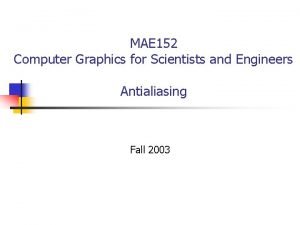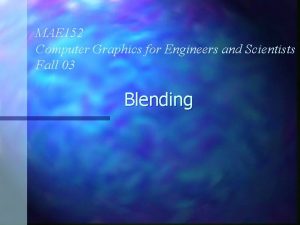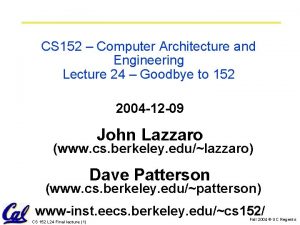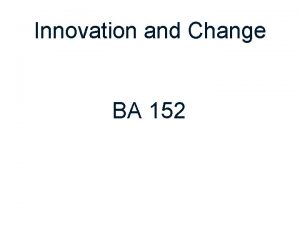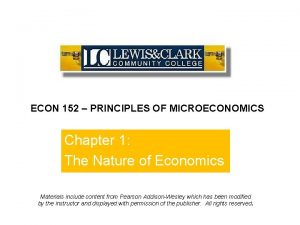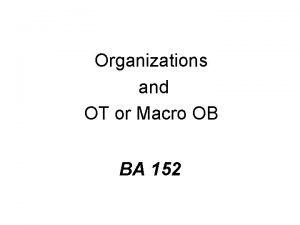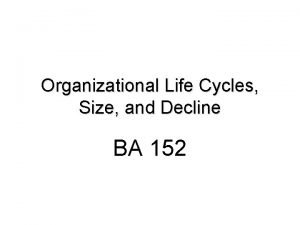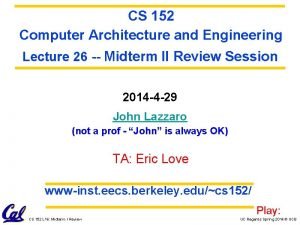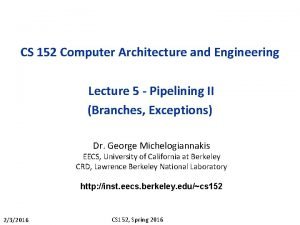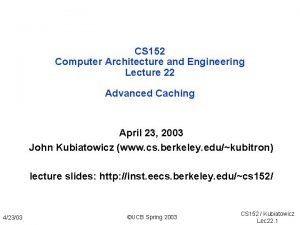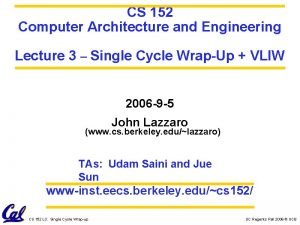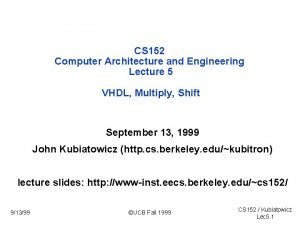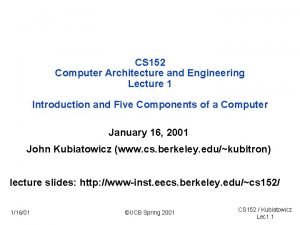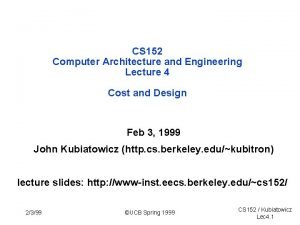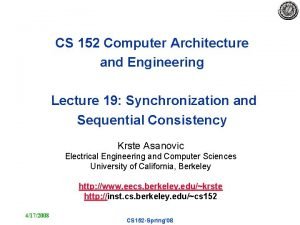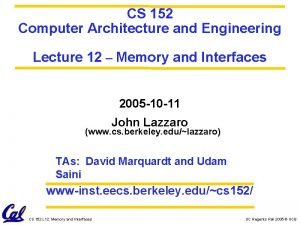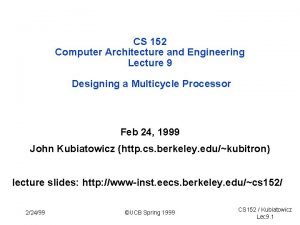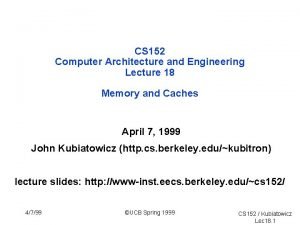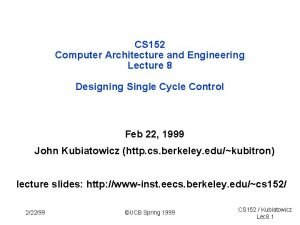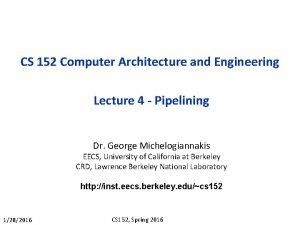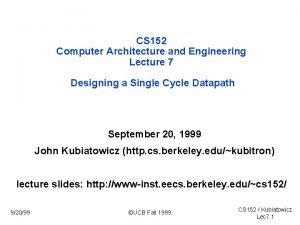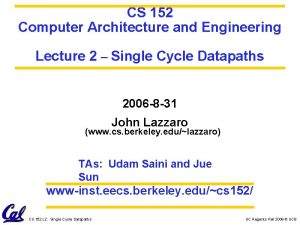CS 152 Computer Architecture and Engineering Lecture 20
























- Slides: 24

CS 152 Computer Architecture and Engineering Lecture 20 Caches Lec 20. 1

The Big Picture: Where are We Now? ° The Five Classic Components of a Computer Processor Input Control Memory Datapath Output ° Today’s Topics: • • Recap last lecture Simple caching techniques Many ways to improve cache performance Virtual memory? Lec 20. 2

The Art of Memory System Design Workload or Benchmark programs Processor reference stream <op, addr>, . . . op: i-fetch, read, write Memory $ MEM Optimize the memory system organization to minimize the average memory access time for typical workloads Lec 20. 3

Example: 1 KB Direct Mapped Cache with 32 B Blocks ° For a 2 ** N byte cache: • The uppermost (32 - N) bits are always the Cache Tag • The lowest M bits are the Byte Select (Block Size = 2 M) • One cache miss, pull in complete “Cache Block” (or “Cache Line”) Cache Tag Example: 0 x 50 Stored as part of the cache “state” Valid Bit Cache Tag 0 x 50 : 9 Cache Index Ex: 0 x 01 Cache Data Byte 31 Byte 63 4 0 Byte Select Ex: 0 x 00 Byte 1 Byte 0 0 Byte 33 Byte 32 1 2 3 : : Byte 1023 : 31 : : Block address Byte 992 31 Lec 20. 4

Set Associative Cache ° N-way set associative: N entries for each Cache Index • N direct mapped caches operates in parallel ° Example: Two-way set associative cache • Cache Index selects a “set” from the cache • The two tags in the set are compared to the input in parallel • Data is selected based on the tag result Valid Cache Tag : : Adr Tag Compare Cache Index Cache Data Cache Block 0 : : Sel 1 1 Mux 0 Sel 0 Cache Tag Valid : : Compare OR Hit Cache Block Lec 20. 5

Disadvantage of Set Associative Cache ° N-way Set Associative Cache versus Direct Mapped Cache: • N comparators vs. 1 • Extra MUX delay for the data • Data comes AFTER Hit/Miss decision and set selection ° In a direct mapped cache, Cache Block is available BEFORE Hit/Miss: • Possible to assume a hit and continue. Recover later if miss. Valid Cache Tag : : Adr Tag Compare Cache Index Cache Data Cache Block 0 : : Sel 1 1 Mux 0 Sel 0 Cache Tag Valid : : Compare OR Hit Cache Block Lec 20. 6

Example: Fully Associative ° Fully Associative Cache • Forget about the Cache Index • Compare the Cache Tags of all cache entries in parallel • Example: Block Size = 32 B blocks, we need N 27 -bit comparators ° By definition: Conflict Miss = 0 for a fully associative cache 31 4 0 Byte Select Ex: 0 x 01 Cache Tag (27 bits long) Cache Tag Valid Bit Cache Data Byte 31 Byte 0 Byte 63 Byte 32 : : = = = : : : Lec 20. 7

A Summary on Sources of Cache Misses ° Compulsory (cold start or process migration, first reference): first access to a block • “Cold” fact of life: not a whole lot you can do about it • Note: If you are going to run “billions” of instruction, Compulsory Misses are insignificant ° Capacity: • Cache cannot contain all blocks access by the program • Solution: increase cache size ° Conflict (collision): • Multiple memory locations mapped to the same cache location • Solution 1: increase cache size • Solution 2: increase associativity ° Coherence (Invalidation): other process (e. g. , I/O) updates memory Lec 20. 8

Design options at constant cost Direct Mapped Cache Size Compulsory Miss Big Same N-way Set Associative Medium Same Fully Associative Small Same Conflict Miss High Medium Zero Capacity Miss Low Medium High Coherence Miss Same Note: If you are going to run “billions” of instruction, Compulsory Misses are insignificant (except for streaming media types of programs). Lec 20. 9

Recap: Four Questions for Caches and Memory Hierarchy ° Q 1: Where can a block be placed in the upper level? (Block placement) ° Q 2: How is a block found if it is in the upper level? (Block identification) ° Q 3: Which block should be replaced on a miss? (Block replacement) ° Q 4: What happens on a write? (Write strategy) Lec 20. 10

Q 1: Where can a block be placed in the upper level? ° Block 12 placed in 8 block cache: • Fully associative, direct mapped, 2 -way set associative • S. A. Mapping = Block Number Modulo Number Sets Direct mapped: block 12 can go only into block 4 (12 mod 8) Fully associative: block 12 can go anywhere Block no. 01234567 Set associative: block 12 can go anywhere in set 0 (12 mod 4) Block no. Block-frame address Block no. 01234567 Set Set 0 1 2 3 111112222233 0123456789012345678901 Lec 20. 11

Q 2: How is a block found if it is in the upper level? Block Address Tag Block offset Index Set Select Data Select ° Direct indexing (using index and block offset), tag compares, or combination ° Increasing associativity shrinks index, expands tag Lec 20. 12

Q 3: Which block should be replaced on a miss? ° Easy for Direct Mapped ° Set Associative or Fully Associative: • Random • LRU (Least Recently Used) Associativity: -way 2 -way Size LRU Random 4 -way 8 LRU 16 KB 5. 2% 5. 7% 5. 0% 4. 7% 5. 3% 4. 4% 64 KB 1. 9% 2. 0% 1. 5% 1. 7% 1. 4% 256 KB 1. 12% 1. 15% 1. 17% 1. 13% 1. 12% 1. 13% Lec 20. 13

Q 4: What happens on a write? ° Write through—The information is written to both the block in the cache and to the block in the lowerlevel memory. ° Write back—The information is written only to the block in the cache. The modified cache block is written to main memory only when it is replaced. • is block clean or dirty? ° Pros and Cons of each? • WT: read misses cannot result in writes • WB: no writes of repeated writes ° WT always combined with write buffers so that don’t wait for lower level memory Lec 20. 14

Write Buffer for Write Through Processor Cache DRAM Write Buffer ° A Write Buffer is needed between the Cache and Memory • Processor: writes data into the cache and the write buffer • Memory controller: write contents of the buffer to memory ° Write buffer is just a FIFO: • Typical number of entries: 4 • Must handle bursts of writes • Works fine if: Store frequency (w. r. t. time) << 1 / DRAM write cycle Lec 20. 15

Write Buffer Saturation Processor Cache DRAM Write Buffer ° Store frequency (w. r. t. time) > 1 / DRAM write cycle • If this condition exist for a long period of time (CPU cycle time too quick and/or too many store instructions in a row): - Store buffer will overflow no matter how big you make it - The CPU Cycle Time <= DRAM Write Cycle Time ° Solution for write buffer saturation: • Use a write back cache • Install a second level (L 2) cache: (does this always work? ) Processor Cache L 2 Cache DRAM Write Buffer Lec 20. 16

RAW Hazards from Write Buffer! ° Write-Buffer Issues: Could introduce RAW Hazard with memory! • Write buffer may contain only copy of valid data Reads to memory may get wrong result if we ignore write buffer ° Solutions: • Simply wait for write buffer to empty before servicing reads: - Might increase read miss penalty (old MIPS 1000 by 50% ) • Check write buffer contents before read (“fully associative”); - If no conflicts, let the memory access continue - Else grab data from buffer ° Can Write Buffer help with Write Back? • Read miss replacing dirty block - Copy dirty block to write buffer while starting read to memory • CPU stall less since restarts as soon as do read Lec 20. 17

Write-miss Policy: Write Allocate versus Not Allocate ° Assume: a 16 -bit write to memory location 0 x 0 and causes a miss • Do we allocate space in cache and possibly read in the block? - Yes: Write Allocate - No: Not Write Allocate Valid Bit Example: 0 x 00 Cache Tag 0 x 50 : Cache Data Byte 31 Byte 63 4 0 Byte Select Ex: 0 x 00 Byte 1 Byte 0 0 Byte 33 Byte 32 1 2 3 : : Byte 1023 : Cache Tag 9 Cache Index Ex: 0 x 00 : : 31 Byte 992 31 Lec 20. 18

Impact of Memory Hierarchy on Algorithms ° Today CPU time is a function of (ops, cache misses) ° What does this mean to Compilers, Data structures, Algorithms? • Quicksort: fastest comparison based sorting algorithm when keys fit in memory • Radix sort: also called “linear time” sort For keys of fixed length and fixed radix a constant number of passes over the data is sufficient independent of the number of keys ° “The Influence of Caches on the Performance of Sorting” by A. La. Marca and R. E. Ladner. Proceedings of the Eighth Annual ACM-SIAM Symposium on Discrete Algorithms, January, 1997, 370 -379. • For Alphastation 250, 32 byte blocks, direct mapped L 2 2 MB cache, 8 byte keys, from 4000 to 4000000 Lec 20. 19

Quicksort vs. Radix as vary number keys: Instructions Radix sort Quick sort Instructions/key Job size in keys Lec 20. 20

Quicksort vs. Radix as vary number keys: Instrs & Time Radix sort Time Quick sort Instructions Job size in keys Lec 20. 21

Quicksort vs. Radix as vary number keys: Cache misses Radix sort Cache misses Quick sort Job size in keys What is proper approach to fast algorithms? Lec 20. 22

Summary #1/ 2: ° The Principle of Locality: • Program likely to access a relatively small portion of the address space at any instant of time. - Temporal Locality: Locality in Time - Spatial Locality: Locality in Space ° Three (+1) Major Categories of Cache Misses: • Compulsory Misses: sad facts of life. Example: cold start misses. • Conflict Misses: increase cache size and/or associativity. Nightmare Scenario: ping pong effect! • Capacity Misses: increase cache size • Coherence Misses: Caused by external processors or I/O devices ° Cache Design Space • • total size, block size, associativity replacement policy write-hit policy (write-through, write-back) write-miss policy Lec 20. 23

Summary #2 / 2: The Cache Design Space ° Several interacting dimensions • • • Cache Size cache size block size associativity replacement policy Associativity write-through vs write-back write allocation Block Size ° The optimal choice is a compromise • depends on access characteristics - workload - use (I-cache, D-cache, TLB) • depends on technology / cost ° Simplicity often wins Bad Good Factor A Less Factor B More Lec 20. 24
 Computer architecture notes
Computer architecture notes Microarchitecture vs isa
Microarchitecture vs isa 01:640:244 lecture notes - lecture 15: plat, idah, farad
01:640:244 lecture notes - lecture 15: plat, idah, farad Difference computer organization and architecture
Difference computer organization and architecture Bus design in computer architecture
Bus design in computer architecture Computer based system engineering
Computer based system engineering What is basic computer organization
What is basic computer organization Unr152
Unr152 Forensics
Forensics Przedszkole 152 łódź
Przedszkole 152 łódź![Re liveri [2006] qca 152 Re liveri [2006] qca 152](data:image/svg+xml,%3Csvg%20xmlns=%22http://www.w3.org/2000/svg%22%20viewBox=%220%200%20200%20200%22%3E%3C/svg%3E) Re liveri [2006] qca 152
Re liveri [2006] qca 152 What is 248 rounded to the nearest hundred
What is 248 rounded to the nearest hundred Mae 152
Mae 152 Blending function in computer graphics
Blending function in computer graphics Cs 152 stanford
Cs 152 stanford Cs 152 berkeley
Cs 152 berkeley Ba 152
Ba 152 Ece 152
Ece 152 Ba 152
Ba 152 Lorne priemaza
Lorne priemaza Which layer of the osi model includes vlans?
Which layer of the osi model includes vlans? Ba 152
Ba 152 Macroob
Macroob Organizational atrophy
Organizational atrophy Hasil dari 202-152 adalah
Hasil dari 202-152 adalah








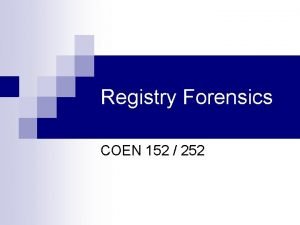

![Re liveri [2006] qca 152 Re liveri [2006] qca 152](https://slidetodoc.com/wp-content/uploads/2020/10/1024173_0ab07c7fa5fe15bbad1bb1a43f32eeb0-300x225.jpg)

